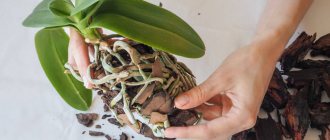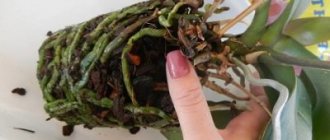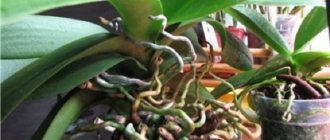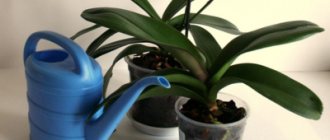In a city apartment, where air humidity is generally 40-50% and the temperature rarely drops below 22 °C, drying out becomes the second most popular cause of death of orchids, after rotting.
However, a drying plant can be saved , but this must be done according to the rules, strictly adhering to certain instructions. Otherwise, improper resuscitation may destroy the orchid.
Main causes of drying out
Errors in care
Errors in care include, first of all: improper watering, as well as abuse or irregular application of fertilizing and fertilizers. There is an opinion that it is necessary to water orchids exactly on schedule, supposedly 1-2 times a week. This is true, but on average.
It should be understood that you need to monitor the plant and respond to its needs in a timely manner. So, in hot weather, the roots in a pot can dry out in a day or two, and if the plant is on a block, then even in a few hours.
It is also very important to take into account the individual preferences of each type of orchid - for example, cymbidiums do not tolerate the slightest drying of the substrate. It’s these little things that make up your care – they all need to be taken into account.
Excess phosphorus or potassium interferes with the absorption of iron, zinc and other trace elements, which in turn leads to chlorosis of leaves, their yellowing and falling. For this reason, it is necessary to feed the plants carefully, dosing fertilizers wisely. Young orchids or children need to reduce the concentration recommended by the manufacturer by 4 times, for adults - by 2.
Unacceptable growing conditions
The normal summer daytime temperature for most orchids is 22-28 °C. At the same time, keep in mind that they react to a temperature of 27-28 ° C with shock and, in an attempt to cool down, begin to actively evaporate moisture from the leaves (consider sweating like a person).
Of course, in a tropical forest, where humidity reaches 70-90%, and the plants themselves are blown and cooled by the wind, this is not scary. But in a closed space, especially a dry city apartment, this is very harmful for the orchid, and with long-term exposure it can lead to overdrying of the substrate and cause depletion.
Too high a temperature leads to drying out of the substrate and roots.
Then the plant begins to get rid of excess load - it dries out and sheds its leaves. Therefore, the only way to revive an orchid that is drying up due to unsuitable conditions is to provide it with optimal conditions.
Advice! Determine air humidity with a hygrometer. Use modern, electronic devices. Cheap Soviet psychrometers such as VIT-2 require strict operating conditions and often give false readings.
Diseases and/or pests
Parasites that suck juices from plant leaves, for example, spider mites, thrive in dry air conditions and can damage orchid leaves , causing it to lose its decorative appearance. It’s the same with diseases - various rots can lead to yellowing, dying, drying out and dropping of foliage.
Also a common occurrence in the bright midday sun is leaf burn or pseudobulb , especially for light-loving species of orchids (vandas, cymbidiums, etc.).
Basic rules for recovery
There are a number of rules that must be taken into account when restoring a flower, otherwise its health may deteriorate. Basic Rules:
- You should not immediately start replanting if the plant has been in a warm place. It is moved to the shade for several hours and only then transplanted.
- To remove a flower from a pot, take it by the base of the stem and slightly loosen it. A flower sitting firmly in a pot can be damaged when pulled out. This can be avoided by soaking it in water. To do this, lower the orchid pot into a bowl of warm water for 1 hour. Then the phalaenopsis is irrigated with a warm shower. At the same time, water should not be allowed to get on the peduncles.
- After water procedures, the orchid needs to be dried. To do this, carefully wipe it with a dry cloth and place it in a bright place.
- To prevent the condition of the flower from deteriorating, you cannot use drugs to accelerate growth during recovery.
- After 3 days after all the actions done, the plant should come to life. If there are no positive results, it is necessary to check the condition of the root system.
- All damaged roots are cut back to healthy tissue. The cutting areas must be disinfected.
Determining the prerequisites for drying out of a particular plant
This can be done visually. If conditions for growth are optimal, it is necessary to carefully examine the plant, first of all, for parasites or diseases.
If you grow incorrectly, double-check your actions and try to find the mistake. A detailed inspection includes the procedure for removing the orchid from the pot.
It may also happen that the plant was flooded, the roots rotted and therefore it experiences a moisture deficiency.
Lack or excess of moisture for an orchid
Insufficient watering. Orchid is a tropical plant. For its healthy growth, warmth and sufficient soil moisture are necessary. With insufficient watering, the amount of moisture in the leaves is reduced, and the plant becomes lethargic and lifeless. When watering, you should be guided not by specific time intervals at which the plant is watered, but by the specific condition of the soil in the pot. The frequency of watering is influenced by many factors: pot size, soil looseness, ambient temperature. You should be guided by the rule - if the upper layers of the soil begin to dry out, the orchid needs watering.
Excess moisture and too dense soils. The orchid loves a humid environment, but air must always circulate between the roots of the plant, i.e. the substrate should be quite loose. Excess moisture makes roots vulnerable to rot.
The orchid is drying up - how to save it?
Even if the orchid has dried out and dropped 2-3 leaves, this does not mean that it will die. Timely adjustments can help correct mistakes and save a drying beauty.
Adjusting temperature and lighting
Since orchids most often dry out due to heat and bright sun , it is necessary to regulate this point. Optimum daytime summer temperatures for growing indoors are 22-26 °C.
If the air is fresh, humid and it is possible to ensure its circulation, then orchids can tolerate a temporary increase in temperature to 30-35 ° C. Move the plant to partial shade or a place where it will receive bright light, but not direct sun.
Orchids should not be exposed to direct sunlight.
The ideal place for growing is the windowsill of an east or west window. In the south, the orchid can be placed in the middle of the room or shaded with tulle.
Correct watering regime
Remember that orchids cannot be watered on a schedule. You need to water when the plant needs it. Pay attention to the color of the roots and condensation inside the pot.
A dried substrate, lack of condensation and gray roots are clear signs that it’s time to water. If the pot is opaque, pay attention to its weight - with a dry substrate it is lighter. In any case, you need to start watering carefully, gradually bringing the roots back to life.
Important! Orchids on blocks must be sprayed daily.
Substrate
It also happens that a plant is planted in an unsuitable substrate. Not all types of orchids can be planted in regular pine bark. Some require a more moisture-intensive substrate, while other species grow in the ground like ordinary plants.
All preferences of each individual species must be taken into account, as well as the conditions in which a particular plant will live. For example, you cannot attach a plant to a block if you plan to grow it in a dry apartment or house.
In this case, resuscitation of a dried orchid will consist of transplanting it into the correct substrate.
Fertilizer rationing
As already noted, excess phosphorus and potassium can lead to damage to the foliage and, accordingly, its drying out. Since this mistake is easier to avoid than to correct later, feed your orchids strictly when they need it and in lower concentrations of fertilizers. This will help avoid overfeeding.
However, if this happened, then:
- first you need to spill the substrate with a large amount of water;
- cut off damaged areas of leaves;
- Do not feed the plant for a month.
Insects and parasites
All insects, if possible, must first be removed mechanically, then the plant must be washed and treated with an insecticide. Actara works best against parasites, but other insecticides can be used.
Various pests of orchids.
Remember to use personal protective equipment and safety precautions when processing.
Fungal diseases
As with feeding, diseases caused by fungi are easier to avoid than to treat later. Use fungicides such as phytosporin. Before processing you need:
- remove the orchid from the pot;
- remove all rotten areas;
- Treat the sections with cinnamon, charcoal or antiseptic (green paint).
After drying, it is necessary to replant into a fresh substrate.
Consequences of improper care
Often it is this reason that leads to the orchid drying out. The following indicates improper care:
- Lack of moisture.
- Excess moisture.
- Burns from direct sunlight.
- From fertilizers. When feeding the flower, make sure that the solution does not get on the roots.
- Fungus.
To avoid the death of a flower, if any problem is detected, they immediately begin to solve it.
Overwatering
Orchid tolerates drought much more easily. Excessive watering leads to rotting of the root system and, as a result, the death of the plant.
Stagnation of water at the roots is unacceptable. They begin to rot, and the flower itself does not receive enough oxygen.
Watering is carried out as follows:
- The orchid is immersed in water for 10-15 minutes, then the liquid is allowed to drain.
- Or using a shower at 40°C. After this procedure, be sure to wipe the growth point dry.
The flower needs moisture when the substrate has become completely dry and the aerial roots have acquired a silvery color. If they are green, then there is no need for watering.
Lack of lighting
Wilting and falling leaves may be a signal that the orchid is lacking light. This is especially true for the winter period.
This tropical beauty has 12 hours of daylight. You can lengthen it with the help of additional lighting - a phytolamp.
Temperature jumps
The orchid is a tropical plant, which means it is heat-loving. Observe the following temperature regime:
- During the day - 20-33°C.
- At night - 18-20°C.
Temperatures above 34°C and below 15°C can cause the flower to wilt.
Violation of the regime is determined by the following signs:
- watery leaves;
- the stems dry out.
Dry air
Epiphytes need moist air. Therefore, when keeping it in an apartment, additional humidification is required, especially during the heating period. Otherwise, the plant will begin to dry out.
Optimal humidity is 80%. And not lower than 50%. Additionally, they humidify the air using special devices or place a container of water next to the plant.
Frequent spraying of an orchid leads to the appearance of fungi and other microorganisms.
Why does the top bud wither?
A common problem faced by many owners of this tropical beauty. The reasons for the withering of the upper bud are as follows:
- End of flowering period. Then not only the bud fades, but also the peduncle.
- Lack of nutrients due to weakening of the root system.
- Incorrect trimming.
The plant is saved by treating the cuts with a special product.
If all care measures are followed, the flower quickly comes to its senses and continues to grow.
Basic methods of resuscitation if it dries out:
By the time the entire plant dries out, it will have exhausted its plastic substances and it will be impossible to save it. However, if the plant has dried only partially and there are still living areas left, then it is still possible to restore it:
- Before resuscitating a dried orchid, remove the plant from the pot and inspect it;
- All dry, rotten and dead parts of the plant should be removed;
- After treating the cuts with antiseptics, spray the plant with zircon and place it in a greenhouse on a cushion of damp (not wet!) sphagnum and expanded clay;
- After two days, treat the orchid with epin;
- If there are no roots left, you can use heteroauxin.
In general, resuscitation of a dried orchid is, in fact, not much different from that if the plant had rotted.
Whole plant but roots are green
Since the roots and foliage are part of one plant and do not live on their own, assessing the viability of the orchid and deciding on further actions must be carried out based on the general condition of the plant. So, living roots are not a sign that it will survive. However, you can try to revive the plant in a mini-greenhouse.
Important! Since the plant has no leaves left, it will have nothing to evaporate moisture with. Flooding the roots will only make the situation worse. Remove all dry areas, spray the roots with stimulants and place what is left in a mini-greenhouse.
Stem
If the stem begins to dry, then, obviously, the cause of drying is in the roots. Since the orchid stores moisture in its terrestrial organs (leaves or pseudobulbs), the fact that the roots have dried/rotted may not immediately become apparent. It often happens that green tops with more or less normal turgor sit in a pot without roots.
In order to revive the plant, it is pulled out of the pot, all dead sections of the roots are cut off and sent for intensive care or replanted. Care is being normalized.
Orchid with a dried stem.
Growth point
For a sympodial orchid, this is not scary . For monopodial, it means that the plant will stop growing. Sooner or later, after the leaves age and dry out, it will die. And before that, the orchid needs to be helped to reproduce itself, that is, to produce offspring - a baby. The shoots, as a rule, in this case appear on the side of the plant or at the roots.
Leaf mass
It is necessary to determine the cause of drying and correct the error. Usually, after correcting all the shortcomings in care and normalizing growth conditions, the plant itself recovers.
Root
- If almost all the roots have dried , then the orchid is sent for intensive care according to the general scenario;
- In case of partial loss, the plant is transplanted into a smaller pot, care and watering are normalized;
- For more confident root growth, use stimulants, for example, heteroauxin.
Dried orchid roots.
Attention! The main task is to grow the roots until the plastic substances are exhausted (before the leaves/pseudobulbs dry out). If everything is done correctly, the orchid calmly grows them and recovers.
Losing even the entire root system does not mean death for an orchid. You just need to identify the cause in time and correct the errors.
Peduncle
Drying of the peduncle by an orchid is a normal phenomenon after flowering has completed. Not all species have perennial flower stalks. Therefore, when it dries completely, it must be removed. If only the top of the peduncle has dried up, then it is partially cut off, 2 cm above the dormant bud.
Why does an orchid dry out?
When an orchid's leaves or roots turn yellow, wilt, and quickly dry out, this means that it is signaling unsuitable conditions for it or improper care. Before starting the rehabilitation process, it is important to identify and eliminate the causes that led to the deplorable condition. There may be several unfavorable factors:
- Most often, an orchid dries out from lack of watering . It is a moisture-loving plant and requires a fairly high humidity of the substrate and surrounding air. If there is not enough moisture, the roots and leaves may dry out.
- Hard water has a detrimental effect . It forms an impenetrable crust on the surface of plant tissue. It destroys the delicate root system, killing the spongy layer on its surface - velamen. If it is destroyed, the orchid cannot absorb nutrients.
- Drafts negatively affect the general condition of the plant . Strong gusts of air cause the leaves to weaken and dry out.
- The scorching rays of the sun cause burns, which cause the leaves to wither and dry out.
Important! Before starting resuscitation, you need to determine exactly why the orchid has dried up, and only after that begin rescue work.
To determine the degree of drying, you need to conduct a full examination of the orchid.
Saving an orchid: why do its leaves dry out, what to do about it and how to prevent it?
Many gardeners, especially beginners, do not pay attention to the drying leaf .
Thus, wasting precious time on treatment and restoration of the plant. The leaves of an orchid can dry out in 2-3 hours. After which the plant may die. That is why you should not delay treatment. It is worth paying attention to even the most minor changes in appearance.
The process of withering and drying of leaves can also affect the health of neighboring indoor plants. Having noticed such changes in the appearance of your pet, you must immediately isolate it from other plants.
Why did the rhizomes change color?
It happens that orchid rhizomes change color and turn yellow. A similar phenomenon occurs because the roots do not have enough light, they are dark. Perhaps, when transplanting, they deepened it quite deeply into the soil, or placed the pot in a dark place. But for exotic handsome men this is unacceptable.
The root system should have enough light and air space. Otherwise, the process of photosynthesis, which produces the pigments responsible for green color, stops. Therefore, it is extremely important to plant orchids in a transparent container with loose, breathable soil.
A serious problem is when yellow roots are the initial stage of rotting. In this case, it will be more difficult to cope with the infectious disease. But, as already noted, the main thing is to recognize the cause in time.
Saving a wilting plant
It is necessary to create a favorable microclimate for the plant with the problem and monitor changes in the orchid’s condition.
It is possible to restore the beginning withering of flowers only by catching the beginning of the process and giving it the correct diagnosis. After all, it could be a draft and even cigarette smoke.
Almost everything can be corrected, something can be removed, dried or moistened, but it is unlikely that it will be possible to influence already withered buds. Most measures are necessary not only to save and restore flowering, but also to gain experience that will prevent a recurrence of the unpleasant situation. It is easier to prevent flowers from wilting prematurely.
Getting rid of pests
An indoor orchid also dries out because it is attacked by parasitic insects. There can be several varieties:
- scale insect - poses the greatest danger to the orchid. The insect feeds on the sap of the plant, which necessarily leads to slower growth and subsequent death. If an orchid dries out due to this harmful insect, there will certainly be small brown tubercles on its leaves;
- aphids - can appear on those plants that live in conditions of lack of moisture and nutrition. The danger of aphids lies not only in the fact that, like the scale insect, they feed on sap: they are capable of infecting the orchid with toxic substances, due to which green and healthy plants gradually turn into a drying, dull mass.
To get rid of pests, the affected plant must be immediately isolated and thoroughly “bathed”: rinse every leaf and root under running water, removing everything that has been significantly damaged. Next, the orchid is sprayed with an insecticidal composition, and after completely getting rid of the “guests”, it is transplanted into a fresh substrate.
What to do if the orchid has dried up?
An orchid, like any other indoor plant, can become sick or be attacked by pests. In this case, the damage can be either minor or very extensive. Upon a quick inspection, it may simply seem to an inexperienced gardener that the orchid has dried up for no apparent reason. You should not immediately throw away such a plant. In most cases it can be saved.
Using growth regulators when caring for an orchid
Experienced gardeners recommend using growth regulators that help strengthen the plant’s immune system. The most commonly used are “Epin” (or otherwise “Epin-Extra”), as well as “Zircon”. These drugs help the orchid regain its strength. Epin should be diluted in a dosage of 1 liter - 1 drop. You can soak the plant in this solution for 20 minutes to 2 hours.
But remember that growth regulators themselves are not a magic panacea for all orchid diseases. In order for the plant to feel good, it is necessary to create favorable growing conditions for it, including maintaining high air humidity and sufficient lighting in the room.
Orchid pest control
The orchid suffers from pests no less than from infections. There are many parasites that love to feast on orchids, in particular phalaenopsis. Here are some of them.
The red flat mite is the most common pest in home greenhouses. Lives on the top of the leaf. It sucks the juices out of the plant, as a result of which the leaf turns yellow, its edges curl, and its lower part acquires a characteristic silvery sheen. Insecticides are ineffective against it; contact-intestinal preparations should be used, making the food poisonous for the tick.
Mealybug - plaque on roots and substrate. Appears on weakened plants due to violation of the maintenance regime, accumulates on flowers and inside the leaves. Remove with cotton swabs, wash with soapy water, spray with “Fitoverm” twice at intervals of a week.
Scale insects and false scale insects live on the trunk and underside of the leaf. A sticky coating appears on the affected parts of the plant. Females lay eggs, covering them with a crust - a shield. The parasite is very difficult to remove. It needs to be treated with a contact-intestinal insecticide, which is poured over the substrate. It is absorbed through the roots into the orchid, and it becomes poisonous to the scale insect. Repeat treatment after a week.
Does the plant need treatment?
Yes, it does, which is why there are special means. The latest development is phytosporin. This is a microbiological preparation designed to combat fungi and bacterial diseases. Fitosporin is effective in the following cases:
- From powdery mildew.
- With bacteriosis.
- With fusarium.
It also destroys pests, but not so effectively, and not always from the first treatment. Due to its low toxicity, home use is recommended. It contains live bacteria.
Phytosporin is available in various forms:
- Liquid or aqueous suspension.
- Powder.
- Pastas.
Fitosporin helps in the following cases:
When withering.
- Black leg.
- Parshe.
- Root rot.
- Late blight.
The drug is used during flowering, growing season and cannot cause any harm to the flower. In cases of severe pest damage, it is unlikely to help - more powerful drugs are needed.
There is also a means for biological plant protection - Trichodermin. The scope of application of Trichodermin is as follows:
- Fungal diseases.
- Increasing flower immunity.
- Growth stimulation.
- For effective control of pests and diseases: powdery mildew, fusarium, late blight, rot.
Important! Unlike Fitosporin, it does not contain bacteria, and is not its analogue. The composition includes a strain of saprophytic fungi related to the genus Trichoderma.











